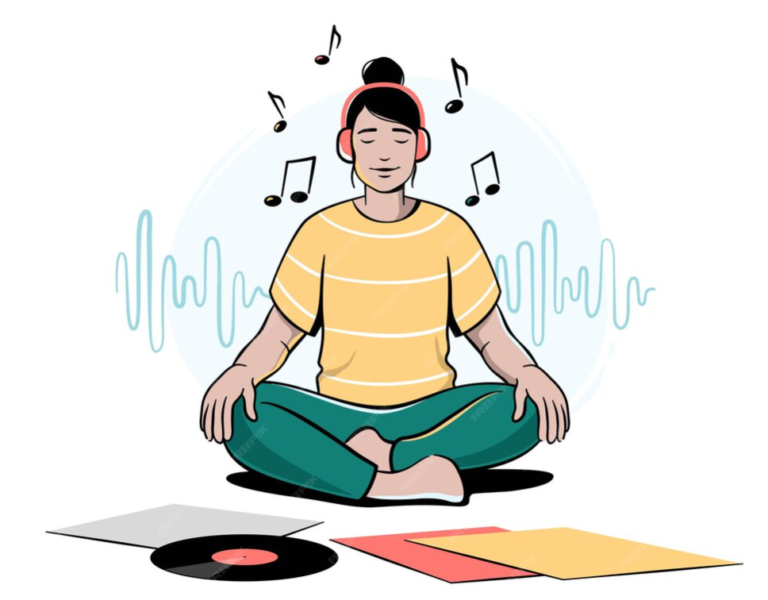Introduction - How to Listen to Binaural Beats Correctly: A Comprehensive Guide

Hey there, fellow sound explorers! Are you ready to unlock a world of relaxation and focus with binaural beats? If your brain is buzzing with curiosity about how to listen to binaural beats correctly, you’re in the right place! This guide is like your trusty map to navigate through the soothing sounds of binaural beats meditation. So, buckle up, and let’s dive right in!
What Are Binaural Beats? 🤔
Before we jump into the nitty-gritty of listening, let’s break it down a bit. Binaural beats are like little sound waves that play tricks on your brain. Picture this: You’ve got two different frequencies playing in each ear. When your brain hears them together, it mixes them up and creates a new sound wave! This magical mix can help you chill out, focus better, or even tap into your creative side. How cool is that?
Why Listen to Binaural Beats? 🌌
Alright, let’s chat about why you’d wanna crank up those binaural beats. The benefits are as sweet as a slice of chocolate cake! Here are a few reasons why people dig them:
1. Relaxation: Feeling stressed? Binaural beats can help you unwind and melt away that tension like ice cream on a sunny day.
2. Focus and Concentration: Need to hit those books or power through a project? Certain frequencies can help you zero in on your tasks like a laser beam!
3. Creativity Boost: If you’re an artist or just wanna think outside the box, binaural beats can spark those creative juices and help you brainstorm like a champ.
4. Better Sleep: Tossing and turning at night? Some people use binaural beats to help them snooze like a baby.
5. Mindfulness and Meditation: They can be a great companion for meditation, helping you reach that Zen state faster than you can say “om.”
The Best Ways to Listen to Binaural Beats 🎧
Now that we know what binaural beats are and why folks love them, let’s chat about how to listen to binaural beats correctly. Grab your headphones, and let’s get this party started!
1. Find Your Space🌟
First thing’s first: Create a chill environment! You wanna find a comfy spot where distractions don’t stand a chance. This could be your cozy corner at home, a quiet park, or even your car (with the engine off, of course!). Make it a place that feels good, so you can sink into the sounds without interruptions.
2.Get Comfy 🛋️
Alright, now it’s time to make yourself comfy! Whether you’re sitting or lying down, get into a position that feels just right. You know, the kind of comfort that makes you wanna sigh like you just found the ultimate couch. Relax your body, take a few deep breaths, and let go of any tension. You got this!
3. Grab Your Headphones 🎧
This is a biggie! You MUST use headphones. Why? Because binaural beats work their magic with stereo sound. When each ear gets a different frequency, your brain does its thing and creates that sweet, soothing sound. So, dig out those headphones or earbuds and get ready to rock ‘n’ roll!
4. Choose the Right Track 🎵
Now for the fun part—picking the right binaural beats track! There are tons out there, tailored for relaxation, focus, sleep, and even creativity. Explore different frequencies until you find the one that vibes with you. It’s like finding your favorite ice cream flavor—there’s something for everyone!
5. Hit Play and Chill 🎶
Once you have your comfy spot, headphones on, and track picked out, it’s time to hit play! Close your eyes, take a deep breath, and let those beats wash over you like a warm hug. You don’t need to force anything; just let your mind drift and enjoy the ride.
6. Give It Time⏳
Patience is key, my friend! Don’t expect instant magic. It might take a few minutes for your mind to adjust to the beats and settle into that relaxed state. Some folks recommend listening for at least 20 minutes for the full benefits. So, kick back, relax, and let the good vibes flow!
7. Practice Regularly 🔄
Just like learning to ride a bike, the more you practice listening to binaural beats, the better you’ll get at it! Make it a part of your daily routine. Whether it’s in the morning to kickstart your day or at night to help you wind down, the consistency can help you maximize those chill vibes.
8. Explore Different Techniques🧘♂️
Once you’re comfortable with binaural beats, you can start exploring different techniques! Try combining them with meditation, deep breathing, or even visualization. Play around and see what feels best for you. It’s all about finding your groove!
Common Mistakes to Avoid 🚫
Now that you’re a binaural beats pro, here are a few rookie mistakes to steer clear of:
1. Listening Without Headphones: This one’s a biggie! Remember, headphones are a must. Otherwise, you’re missing out on the whole binaural experience.
2. Multitasking: Trying to work or scroll through your phone while listening? Nope, that’s a no-go! Give yourself the time to soak in the beats and truly relax.
3. Rushing the Process: Don’t rush it, buddy! Allow yourself the time to get lost in the sounds. It’s not a race; it’s a journey.
Frequently Asked Questions (FAQ) ❓
What are binaural beats used for?
Binaural beats are used for relaxation, focus, enhancing creativity, sleeping better, and even aiding meditation. They can help you tune into different brainwave states, depending on the frequency you choose.
How long should I listen to binaural beats?
While it varies from person to person, listening for at least 20-30 minutes is usually recommended to experience the full benefits. Just find a comfortable spot and let the beats take you away!
Can I listen to binaural beats while I sleep?
You bet! Many folks like to listen to binaural beats as they drift off to sleep. Just find a relaxing track and let it work its magic while you snooze.
Is there a specific frequency I should listen to?
Different frequencies serve different purposes. For example, 4 Hz is great for deep meditation, while 10 Hz can help with focus. Explore and see which frequencies resonate with you!
Can anyone listen to binaural beats?
Absolutely! Just remember to use headphones and find a quiet space. It’s a great way to relax and tap into your inner zen!
Conclusion 🎉
And there you have it, my binaural beats buddies! You’re now equipped with all the knowledge you need to listen to binaural beats correctly and make the most out of your meditation journey. Whether you’re looking to chill out, focus better, or just wanna explore a new way of relaxing, binaural beats can be your ultimate sidekick.
So, go ahead and find your comfy spot, pop on those headphones, and let the beats flow! Remember, it’s all about enjoying the process, so don’t rush it. Happy listening, and may your days be filled with good vibes and sweet sounds! 🎶✨
CLICK ON THE IMAGE BELOW AND GET FULL ADVANTAGE BY USING BINAURAL BEATS MEDITATION


